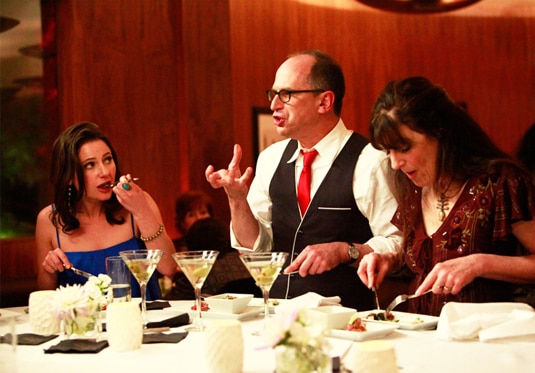Impossibly Glamorous
James Oseland shares his love for this week's 1960s classics.

I’d like to start by saying something that means a lot to me: Hugh is back! His departure was perhaps one of the most difficult things I’ve witnessed over the course of three seasons of Top Chef Masters. Sure, John Sedlar will be missed—John, we hardly knew ye!—but Ruth, Curtis, Danielle, and I were uniformly elated to welcome Hugh back to the fold. He’s a talented, intelligent chef, and sending him home last week didn’t feel like the right thing to do (in spite of that salty scallop). Lo and behold, he proved his skill this week by acing not one but two preparations of beef Wellington, perhaps one of the all-time most challenging dishes to make.
The gorgeous Christina Hendricks introduced this week’s Elimination Challenge by telling the cheftestants that she disliked the food of the 1960s. Christina obviously has great taste in all sorts of things—a charming husband among them—but on this particular matter, I must disagree. In the 1960s, when I was a kid, my dad was an office-products salesman (he traveled the country selling Bic pens and desktop blotters), and wherever he was, he would stop at restaurants that I imagined were impossibly glamorous, serving food that I considered to be the absolute pinnacle of sophistication. Whenever Dad returned from a trip, he’d go right into the kitchen and duplicate the dishes he’d had at these restaurants: beef Stroganoff, grasshopper pie—foods that, to this day, I absolutely love.
But there was one 1960s creation to which my dad exposed me that stood out above all the others: Duck à l’orange was to me the ideal food and the very definition of high-end dining. So it was a bit disappointing that it was that dish that wound up sending a chef home on this week’s episode. Neither of Sue Zemanick’s versions was outstanding. Still, I’m not sure that it was a plate of food bad enough to go home over. Could Sue’s food have been better? Could it have been more flavorful? Could there have been a better differentiation between the original and the updated rendition? Yes, yes, and yes. Sue’s duck wasn’t terrific, but it was tasty.
Suvir’s veal Oscar, on the other hand, was like shoe leather. At the Critics’ Table, we learned that the chef had made the decision to deep-fry the meat after not snagging enough space on the stovetop. Politeness is a virtue, but if Sue’s dish hadn’t been such a disappointment, Suvir’s policy of nonintervention could have been a fatal mistake—he needed to push someone out of the way and gently sauté that veal! At least Suvir had the excuse that his dish was bizarre to begin with—veal Oscar is an oddball, timepiece recipe that was created more for its symbolic resonance than for its flavor. It was developed in 1905 to honor King Oscar II of Sweden, incorporating his royal colors and various symbols of his monarchy (the white asparagus spears that adorn its top, for instance, were meant to represent the “II” in his title). There are plenty of reasons pretty much no one makes the dish anymore. But Alex Stratta had no excuse for blowing bread pudding. Of all the dishes the cheftestants could have drawn, bread pudding—along with deviled eggs—was one of the softballs. Mary Sue took the opportunity of her easy draw to knock something out of the park (more on that later), but I was surprised by Alex’s lack of both skill and innovation. Even if, as he said, he’d never made bread pudding before, it’s a fundamental dish, and both his original and his updated version lacked the level of execution that I would expect from a Top Chef Master. Had Sue not run out of time with her plating, I suspect Alex might have gone home this week.
But the good food far outweighed the bad. I think this might have been the single most successful challenge I’ve ever judged. Those who were at the top of their game created not just inspired updates of retro recipes, but also pitch-perfect renditions of the original dishes—in a few instances, the best versions I’ve ever eaten. George’s chicken à la king didn’t get much airtime, but it deserves special mention: Both the original and the update (a roast chicken breast daintily wrapped in blanched chard) were clearly the work of a serious contender in this competition. Floyd’s ambrosia was also revelatory. Not just his masterfully deconstructed update—which, perhaps more than any other chef’s dish, was a faithful reinterpretation of its source material—but the original as well. Who knew that ambrosia made with fresh fruit and just-whipped cream could be a masterpiece in itself?
But even against exceptionally strong showings from so many of the chefs, Mary Sue’s deviled eggs and John’s versions of oysters Rockefeller were astronomical culinary achievements. I would have been happy to see either of them win, but Mary Sue did something that really touched me—something that made her win even sweeter. On last week’s episode, when we almost sent her home thanks to a snoozy chocolate cupcake, we asked her to challenge herself, to not just cook dishes that she already had in her professional Rolodex. And this week, she did just that: We could taste her willingness to push herself, as a chef, as an artist, as a competitor on the show. Her mastery was real. It was on the plate in front of us, and it tasted extraordinary.
James Oseland is the editor-in-chief of Saveur magazine.



